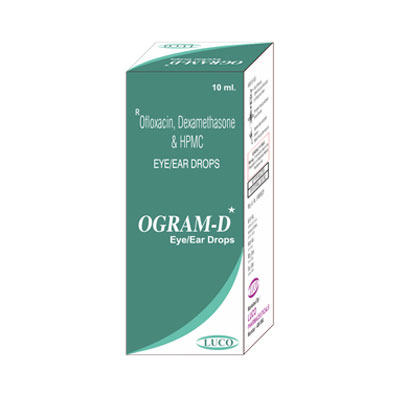
Ofloxacin, Dexamethasone with HPMC Eye/Ear Drops
Composition:
1 ml of the solution contains:
Ofloxacin IP 0.3% w/v + Dexamethasone Sodium Phosphate IP 0.1% w/v + Hydroxypropylmethyl Cellulose IP 0.25% w/v + Benzalkonium Chloride Solution IP 0.02% v/v, Sterile Aqueous Base q.s.
Trade Name :
Ogram D
Description :
Ogram D Eye/Ear Drops is a combination of Ofloxacin, a fluoroquinolone antimicrobial and dexamethasone, a potent corticosteroid.
Indications :
Ogram D is indicated for steroid-responsive inflammatory ocular conditions for which a corticosteroid is indicated and where bacterial ocular infection or a risk of infection exists.
Ogram D is indicated in inflammatory conditions of the palpebral and bulbar conjunctiva, cornea and anterior segment of the globe where the inherent risk of steroid use in certain infective conjunctivitis is accepted to obtain a diminution in oedema and inflammation.
It is also indicated in chronic anterior uveitis and corneal injury from chemical radiation, thermal burns, or penetration of foreign bodies, where the risk of infection is high or where there is an expectation that potentially dangerous numbers of bacteria will be present in the eye.
Ogram D is indicated for the treatment of ear infections accompanied by inflammation such as otitis externa, acute and chronic otitis media and can be used postoperatively.
Dosage and Administration :
For ocular conditions: One or two drops instilled into the conjunctival sac every 4 to 6 hours. During the initial 24 to 48 hours, the dosage may be increased to one to two drops every 2 hours. Frequency should be decreased gradually or warranted by improvement in clinical signs. Care should be taken not to discontinue therapy prematurely.
For Ears: Instill 2-4 drops 3-4 times daily.
Contraindications :
The use of Ogram D is contraindicated in patients with hypersensitivity to any ingredient of the formulation.
The use of Ogram D is also contraindicated in epithelial herpes simplex keratitis (dendritic keratitis), vaccinia, varicella, and in other viral diseases of the conjunctiva and cornea, mycobacterial infection of the eye and fungal diseases of ocular structures.
Warning and Precautions :
NOT FOR INJECTION.
Ogram D solution should not be injected subconjunctival, nor should it be introduced directly into the anterior chamber of the eye.
The prolonged use of antibiotics may occasionally result in overgrowth of non- susceptible organisms, including fungi. If new infections appear the drug should be discontinued and appropriate measures instituted.
Prolonged use of may result in glaucoma and posterior sub-capsular cataract formation. If these products are used for 10 days or longer, intra-ocular pressure should be routinely monitored even though it may be difficult in children and uncooperative patients.
Adverse Effects :
The most frequently reported drug-related adverse reactions seen with Ofloxacin are: transient ocular burning or discomfort.
Other reported reactions include stinging, redness, itching, conjunctivitis/keratitis, periocular/facial oedema, foreign body sensation, photophobia, blurred vision, tearing, dryness, and eye pain.
The reactions due to the steroid component are: elevation of intraocular pressure with possible development of glaucoma, and infrequent optic nerve damage, posterior sub-capsular cataract formation and delayed wound healing.
CLINICAL PHARMACOLOGY :
Mechanism of Action :
Ofloxacin has in vitro activity against a broad range of gram-positive and gram negative aerobic and anaerobic bacteria. It is bactericidal at concentrations equal to or slightly greater than inhibitory concentrations.
Ofloxacin is thought to exert a bactericidal effect on susceptible bacterial cells by inhibiting DNA gyrase, an essential bacterial enzyme that is a critical catalyst in the duplication, transcription, and repair of bacterial DNA.
Ofloxacin has been shown to be active against most strains of the following organisms both in vitro and clinically:
Aerobic Gram-Positive : Staphylococcus aureus, Staphylococcus epidermidis, Streptococcus pneumoniae.
Aerobic Gram-Negative : Enterobacter cloacae, Haemophilus influenza, Proteus mirabilis, Pseudomonas aeruginosa, Serratia marcescens, Moraxella catarrhalis, Escherichia coli.
Anaerobic Species : Propionibacterium acnes
Corticosteroids like Dexamethasone suppress the inflammatory response to a variety of agents. Since they may inhibit the body's defence mechanism against infection, a concomitant antimicrobial drug may be necessary when this inhibition is considered to be clinically significant
USE IN SPECIFIC POPULATIONS :
Pregnancy Teratogenic Effects : There are no adequate and well-controlled studies in pregnant women. Orgarm D should be used during pregnancy only if the potential benefit justifies the potential risk to the foetus.
Nursing Mothers : It is not known whether this drug is excreted in human milk. Because many drugs are excreted in human milk, caution should be exercised when Ogram D is administered to a nursing woman.
Paediatric Use :
Safety and efficacy in paediatric patients below the age of one year have not been established.
Geriatric Use :
No overall clinical differences in safety or effectiveness have been observed between elderly and other adult patients.
Packaging :
10 ml round low density polyethylene bottle with a dispensing plug and white polypropylene screw cap containing 10 ml solution.
Storage Conditions :
In dry place protected from light at a temperature below 25°С. Do not freeze. After instillation the vial should be tightly closed. Keep out of reach of children.
Shelf-Life :
15 months after opening the vial it is suitable for use within 1 month.
Do not use after the expiration date stated on the package.

OPHTHAL